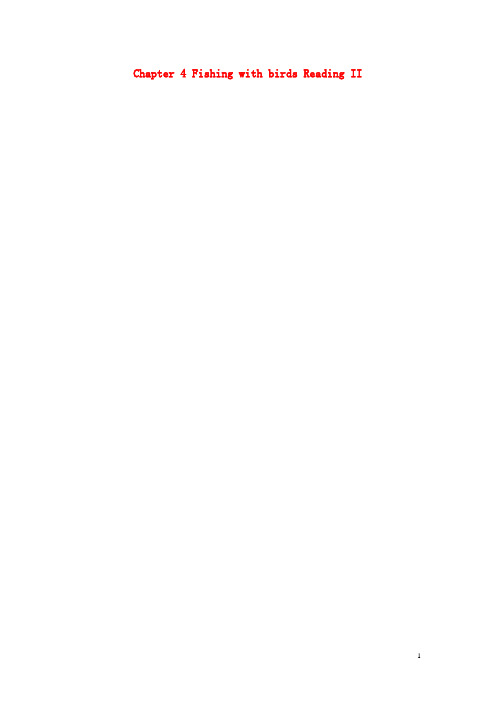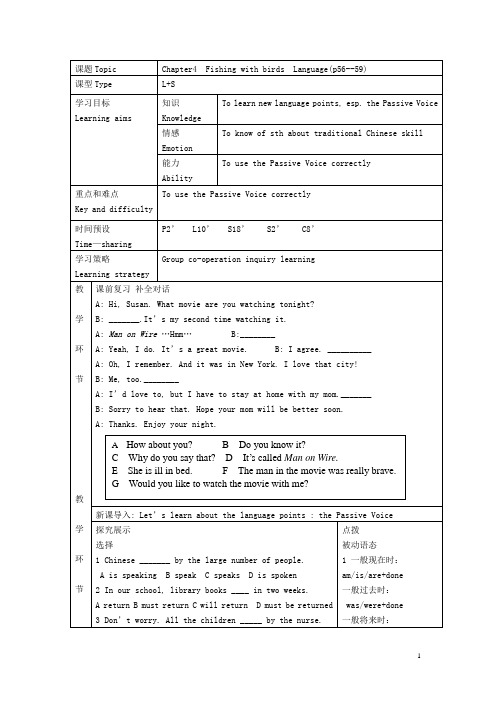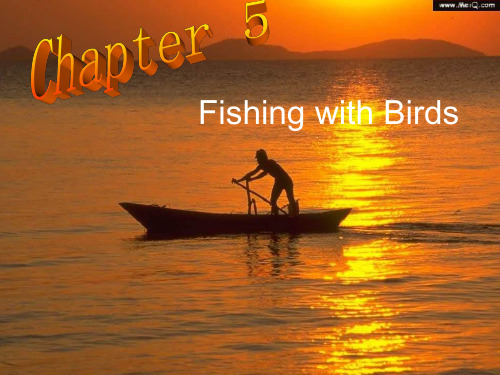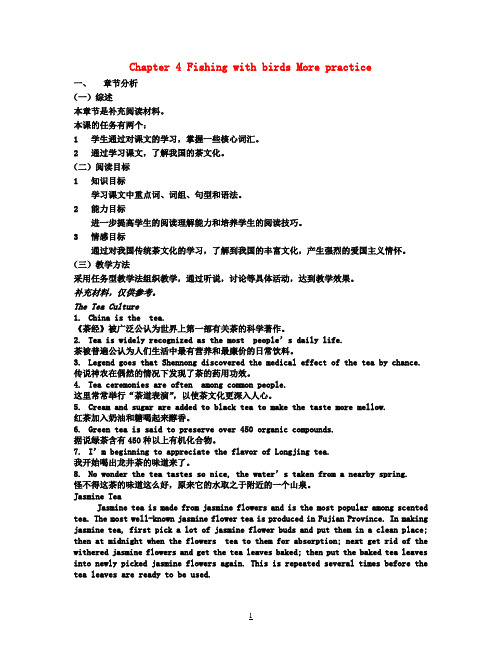九年级英语上册Chapter4FishingwithbirdsLanguageandwriting教案牛津沈阳版
- 格式:doc
- 大小:57.00 KB
- 文档页数:9





初三英语Chapter 4 Fishing with birdsReading 2某某牛津版知识精讲【同步教育信息】一. 本周教学内容:[学习过程]一、本讲主要内容(一)课文语言点归纳(二)课后练习总结二、本周知识总结与归纳(一)课文语言点归纳1. on the side of the river2. with something somewhereWang Daming sits on the side of the river cooking a meal, with a large bird on his head. 3. of average heightHe is thin, and of average height, but he is very fit.4. be used to do sth. be used to sth/doing sth used to do sthTheir large feet are used to push them quickly through the water.She is used to getting up early in the morning.Grand ma used to be a teacher. And now she is retired.5. requireDaming doesn’t require nets or a fishing rod to catch fish.require doing sth=require to be donerequirement n.We have a lot of requirement of food.6. set off=set outDaming sets off on his bamboo raft with his birds.7. reach the right placereach=get to=arrive in (at)8. so that=in order thatA piece of grass is tied around the neck of each bird, so that it can not swallow the fish.9. be frightenedThe fish are frightened by this.frighten v. frightening adj.10. hang v. (hung, hung )At night, a light is hung from the front of the raft.11. enable sb to do sthThis enables the fisherman to see better, and also attracts the fish.12. attract v. attraction n. attractive adj.13. remove sth fromThe fish are then removed from the birds’ mouths by the fisherman.14. the rest… the rest are divided between Daming’s family and the birds.15. be interested in= be interested to doFew young people are interested in doing such type of work in the modern world.16. no more=not… any longerIn fifty years, perhaps there will be no more cormorant fisherman in the world.(二)课后练习总结C1 Find these words in the article. Then read the words around them and choose the best meaning.1. fitA. healthy, able to work hardB. fat from eating too muchC. brown, with dark skin2. control (his raft)A. carry it on his backB. make it go where he wantsC. build it from pieces of wood3. requireA. makeB. sellC. need4. bangsA. movesB. hitsC. jumps into5. is hungA. is fixedB. is thrownC. is switched6. removed fromA. put intoB. dropped fromC. taken out ofC2 Find the words in Column A in the article, and then match them with the meaning in Column B.A B1. of average height a. new, recent2. elderly b. done for many years in the same way3. sets off c. helps, allows4. traditional d. not tall and not short5. modern e. starts (to go somewhere)6. enables f. older than about 60D1 Each of these sentences has one incorrect word or number. Cross out the mistake and write down the correct word or number. Look back at the article carefully to check your answers.1. Wang Daming sometimes sits with a large fish on his head. bird2. Daming is over 56 now, but he works every day. 653. Cormorants are large, black birds, about a kilometer long. metre4. Cormorants use their wings to push them through the water. feet5. Daming often goes fishing in the morning. afternoon6. He ties a piece of grass around the neck of each fish. bird7. At night, he has a fire on his raft so that he can see better. light8. The fish are removed from the fishermen’s mouths. birds’D2 What do the words in italics below refer to? Look back at the article to find out. Choose the right answers.1. That is done for him…A. Catching fishB. Using a net or fishing rod2. The fish are frightened by this.A. the jumping and bangingB. a large cormorant3. This enables the fisherman…A. The raftB. The light【模拟试题】(答题时间:30分钟)一、根据提示写单词1. I’m neither tall nor short for my age.2. We started our journey early in the morning.3. My uncle goes fishing on a very small thing like a boat.4. I took out my books from my bag.5. This is a bird that catches fish.6. This is a plant that we can use to make rafts.7. This is a long piece of wood.8. This is a long piece of wood with string for catching fish.9. Why don’t we fix this picture on the wall?10. We live in a very new flat.11. I hit my squash racket against the wall.12. Cormorant fishing is a very old way to catch fish.二、单项选择A)选择与句中画线部分意思相同或相近的词或短语。

Chapter 4 Fishing with birds More practice一、章节分析(一)综述本章节是补充阅读材料。
本课的任务有两个:1学生通过对课文的学习,掌握一些核心词汇。
2通过学习课文,了解我国的茶文化。
(二)阅读目标1知识目标学习课文中重点词、词组、句型和语法。
2能力目标进一步提高学生的阅读理解能力和培养学生的阅读技巧。
3情感目标通过对我国传统茶文化的学习,了解到我国的丰富文化,产生强烈的爱国主义情怀。
(三)教学方法采用任务型教学法组织教学,通过听说,讨论等具体活动,达到教学效果。
补充材料,仅供参考。
The Tea Culture1.China is the tea.《茶经》被广泛公认为世界上第一部有关茶的科学著作。
2.Tea is widely recognized as the most people’s daily life.茶被普遍公认为人们生活中最有营养和最廉价的日常饮料。
3.Legend goes that Shennong discovered the medical effect of the tea by chance. 传说神农在偶然的情况下发现了茶的药用功效。
4.Tea ceremonies are often among common people.这里常常举行“茶道表演”,以使茶文化更深入人心。
5.Cream and sugar are added to black tea to make the taste more mellow.红茶加入奶油和糖喝起来醇香。
6.Green tea is said to preserve over 450 organic compounds.据说绿茶含有450种以上有机化合物。
7.I’m beginning to appreciate the flavor of Longjing tea.我开始喝出龙井茶的味道来了。
Chapter 4 Fishing with birds Language and writing【本讲教育信息】一. 教学内容:Chapter 4 Fishing with birds Language and writing(一)被动语态(二)书面表达写作练习二. 本周知识总结与归纳(一)被动语态被动语态概述英语的语态是通过动词形式的变化表现出来的。
英语中有两种语态:主动语态和被动语态。
主动语态表示主语是动作的执行者。
例如:Many people speak Chinese.谓语:speak的动作是由主语many people来执行的。
被动语态表示主语是动作的承受者,即行为动作的对象。
例如:Chinese is spoken by many people.主语English是动词speak的承受者。
1、被动语态的构成被动语态由“助动词be+及物动词的过去分词”构成。
人称、数和时态的变化是通过be的变化表现出来的。
现以speak为例说明被动语态在各种时态中的构成。
一般现在时:am/is/are+spoken一般过去时:was/were+spoken一般将来时:will/shall be+spoken现在进行时:am/is/are being+spoken过去进行时:was/were being+spoken现在完成时:have/has been+spoken过去完成时:had been + spoken2、被动语态的用法(1)不知道或没有必要说明动作的执行者是谁。
例如:Some new computers were stolen last night. 一些新电脑在昨晚被盗了。
(不知道电脑是谁偷的)This bridge was founded in 1981.这座桥竣工于1981年。
(2)强调动作的承受者,而不强调动作的执行者。
例如:The glass was broken by Mike.玻璃杯是迈克打破的。
This book was written by him.这本书是他写的。
Your homework must be finished on time.你们的家庭作业必须及时完成。
3、主动语态变被动语态的方法(1)把主动语态的宾语变为被动语态的主语。
(2)把谓语变成被动结构(be+过去分词)(根据被动语态句子里的主语的人称和数,以及原来主动语态句子中动词的时态来决定be的形式)。
(3)把主动语态中的主语放在介词by之后作宾语,将主格改为宾格。
例如:All the people laughed at him.He was laughed at by all people.They make the bikes in the factory.The bikes are made by them in the factory.He cut down a tree.A tree was cut down by him.书中练习讲解A11. Cormorants.2. Cormorants.3. Damin.4. Damin.A21. A2. P3. P4. A5. P6. PA31. is raised2. are examined3. is removed4. is hatched5. is watched6.is looked7. is fed 8. is controlled 9. are not allowed 10. is takenB1. by artists2. by businessman3. by lorry4. by workers5. by shop assistants6. by tourists7. by plane8. by these paintingsC1. was employed by the French producer2. were interviewed by the interpreter3. was chosen by the producer4. were transported by lorry5. was used by the cameraman6. was filmed by the crew(二)书面表达写作练习Chen Huaming is a dough sculptor. He is very skillful and has good eyesight. He also works well with his hands. Chen is quite patient because dough sculpting takes a long time and a lot of effort. His creative imagination helps him to think of interesting things to make. When he works, he wears simple, old clothes. They usually get dirty when he works.The skill of dough making is often learnt from family members. Chen’s father started teaching him when he was only five years old. The materials needed are easy to get and the preparation is simple. Water, wheat flour and glutinous wheat flour are mixed together, boiled and then allowed to cool down. Adding chemicals helps the dough to last longer. Only very simple tools are used to shape the dough.Chen works either at his home or in a studio. He turns the basic mixture into shapes. These shapes are of many different sizes and colours and there are a lot of influences on his style.He likes to show ancient Chinese culture in his work and the shapes can be very detailed. Chen thinks that dough figures are a very good thing to collect.The ancient Chinese craft of dough sculpting first appeared in the Han Dynasty (206BC-220). During the Song Dynasty, the colourful figures decorated banquets. In later years, they were used as ritual offerings to gods for weddings and festivals. art is quickly disappearing, like many other traditional crafts. In a few years, it could disappear completely.中国书法艺术说课教案今天我要说课的题目是中国书法艺术,下面我将从教材分析、教学方法、教学过程、课堂评价四个方面对这堂课进行设计。
一、教材分析:本节课讲的是中国书法艺术主要是为了提高学生对书法基础知识的掌握,让学生开始对书法的入门学习有一定了解。
书法作为中国特有的一门线条艺术,在书写中与笔、墨、纸、砚相得益彰,是中国人民勤劳智慧的结晶,是举世公认的艺术奇葩。
早在5000年以前的甲骨文就初露端倪,书法从文字产生到形成文字的书写体系,几经变革创造了多种体式的书写艺术。
1、教学目标:使学生了解书法的发展史概况和特点及书法的总体情况,通过分析代表作品,获得如何欣赏书法作品的知识,并能作简单的书法练习。
2、教学重点与难点:(一)教学重点了解中国书法的基础知识,掌握其基本特点,进行大量的书法练习。
(二)教学难点:如何感受、认识书法作品中的线条美、结构美、气韵美。
3、教具准备:粉笔,钢笔,书写纸等。
4、课时:一课时二、教学方法:要让学生在教学过程中有所收获,并达到一定的教学目标,在本节课的教学中,我将采用欣赏法、讲授法、练习法来设计本节课。
(1)欣赏法:通过幻灯片让学生欣赏大量优秀的书法作品,使学生对书法产生浓厚的兴趣。
(2)讲授法:讲解书法文字的发展简史,和形式特征,让学生对书法作进一步的了解和认识,通过对书法理论的了解,更深刻的认识书法,从而为以后的书法练习作重要铺垫!(3)练习法:为了使学生充分了解、认识书法名家名作的书法功底和技巧,请学生进行局部临摹练习。
三、教学过程:(一)组织教学让学生准备好上课用的工具,如钢笔,书与纸等;做好上课准备,以便在以下的教学过程中有一个良好的学习气氛。
(二)引入新课,通过对上节课所学知识的总结,让学生认识到学习书法的意义和重要性!(三)讲授新课1、在讲授新课之前,通过大量幻灯片让学生欣赏一些优秀的书法作品,使学生对书法产生浓厚的兴趣。
2、讲解书法文字的发展简史和形式特征,让学生对书法作品进一步的了解和认识通过对书法理论的了解,更深刻的认识书法,从而为以后的书法练习作重要铺垫!A书法文字发展简史:①古文字系统甲古文——钟鼎文——篆书早在5000年以前我们中华民族的祖先就在龟甲、兽骨上刻出了许多用于记载占卜、天文历法、医术的原始文字“甲骨文”;到了夏商周时期,由于生产力的发展,人们掌握了金属的治炼技术,便在金属器皿上铸上当时的一些天文,历法等情况,这就是“钟鼎文”(又名金文);秦统一全国以后为了方便政治、经济、文化的交流,便将各国纷杂的文字统一为“秦篆”,为了有别于以前的大篆又称小篆。
(请学生讨论这几种字体的特点?)古文字是一种以象形为主的字体。
②今文字系统隶书——草书——行书——楷书到了秦末、汉初这一时期,各地交流日见繁多而小篆书写较慢,不能满足需要,隶书便在这种情况下产生了,隶书另一层意思是平民使用,同时还出现了一种草写的章草(独草),这时笔墨纸都已出现,对书法的独立创作起到了积极的推动作用。